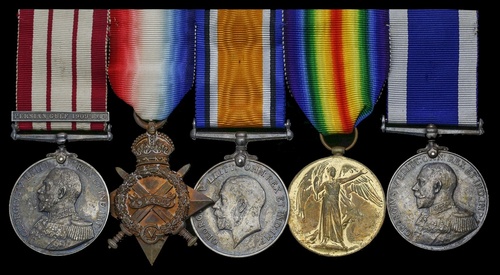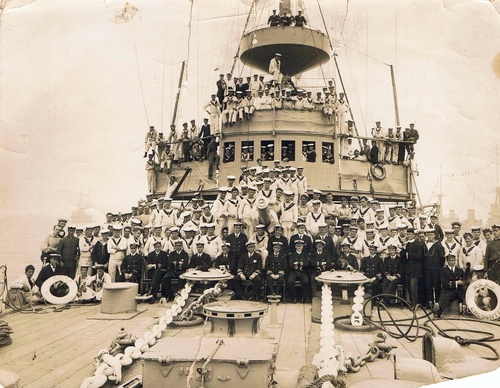Auction: 17002 - Orders, Decorations and Medals
Lot: 164
A fine Great War 'Red Sea Patrol' group of five awarded to Chief Petty Officer A. Sinclair, Royal Navy: service in the cause of Lawrence of Arabia's operations aside - during which he welcomed aboard the occupants of a brace of Turkish harems - he may be counted among the founder members of the Royal Australian Navy
Naval General Service 1915-62, 1 clasp, Persian Gulf 1909-1914 (177790 A. Sinclair, Ch. P.O., H.M.S. Alert); 1914-15 Star (177790 A. Sinclair, C.P.O., R.N.); British War and Victory Medals (177790 A. Sinclair, C.P.O., R.N); Royal Navy L.S. & G.C., G.V.R., 1st issue (177790 A. Sinclair, P.O. 1 Cl., H.M.S. Encounter), mounted as worn, generally very fine and better (5)
Alexander Sinclair was born on Stroma, off the north coast of Scotland, in November 1878. In common with fellow islanders, he found employment as a fisherman; others worked as crofters and some as maritime pilots to guide vessels through the treacherous waters of the Pentland Firth. The tides and currents meant that shipwrecks were frequent and salvage provided an additional - though often illegal - supplement to the islanders' incomes. A lighthouse was built on Stroma in 1890 and it still operates under automation to this day: the island is otherwise abandoned, an all-time peak of 375 inhabitants in 1901 having been reduced to just 12 by the early 1960s.
Alexander's experiences as a fisherman in the treacherous waters off Stroma served him well for, having entered the Royal Navy as a Boy 2nd Class in November 1896, he gained rapid advancement to Petty Officer status in April 1900: a remarkable achievement by any standards.
Australian interlude
A notable appointment in the period leading up to the Great War was his time in H.M.S. Encounter from April 1910 until June 1912, which ship formed part of the Royal Navy's Australia Squadron. Herbert Wilson, a fellow Petty Officer aboard Encounter, later published his personal log covering the same period, including an account of the British expedition to Vava'u islands for the total solar eclipse of 28 April 1911. Encounter was subsequently commissioned into the Royal Australian Navy:
'With the post-1909 expansion of the Australian Navy underway, Encounter was lent by the British Admiralty for use as a sea-going training ship pending completion of the new light cruiser H.M.A.S. Brisbane. Volunteers were called for from the existing ship's company to form a nucleus crew, remaining for a further three years in the Australian Service and receiving Australian rates of pay. Nearly a third of the men decided to stay behind [Sinclair among them]. Encounter was a popular ship, and it was only fit and proper, wrote one of those returning to England, 'that the Encounter with her fine record, should become the foster-mother of the Royal Australian Navy'; https://laststandonzombieisland.com/tag/hmas-encounter/ refers.
Awarded his L.S. & G.C. Medal in Encounter in January 1912, Sinclair was serving as a Chief Petty Officer in H.M.S. Alert on the outbreak of hostilities in August 1914, and it was in this capacity that he was awarded his Naval General Service Medal for services in the Persian Gulf.
Red Sea Patrol
He soon removed to the auxiliary cruiser R.I.M.S. Northbrook, thus commencing a period of extended service in the Red Sea Patrol, a period indelibly linked with Lawrence of Arabia: as the great man once observed, 'The naval side of the operations, when the time comes to tell of it, will provide a most interesting case of the value of command at sea.'
Northbrook's part in that 'command at sea' is the subject of extensive coverage in John Johnson-Allen's T. E. Lawrence and The Red Sea Patrol - The Royal Navy's Role in Creating the Legend; see, too, Northbrook's ship's logs, covering the period April 1915 to July 1918:
http://www.naval-history.net/OWShips-WW1-75-RIMS_Northbrook.htm
Sinclair - a Chief Petty Officer - must surely have been at the forefront of Northbrook's landing parties in such successful operations as the capture of Diba and Mowila in February 1917.
In the landings on Salif, on 11 June 1917, Northbrook's crew contributed to a 250-strong force of Bluejackets and Marines that overwhelmed the Turkish positions and took 127 prisoners, in addition to two guns and three machine-guns, the whole for a loss of one killed and two wounded: notable among the civilians subsequently evacuated in Northbrook were the occupants of two Turkish harems.
Sinclair removed to the R.I.M.S. Dufferin in the summer of 1918 and finally came ashore in August 1919; sold with the recipient's original parchment Certificate of Service.
Subject to 20% VAT on Buyer’s Premium. For more information please view Terms and Conditions for Buyers.
Sold for
£850







